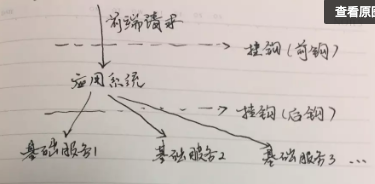php钩子程序设计
2017-01-16 18:41
423 查看
序
作为程序员,设计出优雅而完美的系统,永远是让我们非常兴奋的事情。高手不在于你会多少语言,而在于你有多高的思想。
在设计中,怎么体现自身价值,那就是要比别人多想几步。
讲钩子程序,起源是对用户提交的参数校验(永远不要相信用户),一开始为了赶工期,按照比较传统的方式,每个接口里重复性的对参数进行过滤。后面随着业务的发展(功能迭代),系统的维护成本越来越高,遂想一个更高级的方式进行处理。借鉴同事之前的代码,使用钩子方式进行重构。
之前写过javascript 钩子机制, 偏后钩,可以互相借鉴下。
脉路

概念
把一段程序块(执行体)通过某种方式挂入系统中,从而获得对系统的控制权。
注意下图挂钩位置:

应用
小的方面: 进行基础的入参校验或消息过滤。
大的方面:组件化,可在系统中进行插拔管理。
优点:
1、降低系统的耦合度;
2、降低开发、测试人力成本,用少量的代码实现高可用功能;
3、提高模块间的可用性;
4、通过配置(配置文件or数据库)的方式升级接口。
缺点:
学习成本过高;
系统复杂度提升;
实现思想
配置文件的方式进行钩子定义、钩子链管理(使用“组”的概念)、挂钩。

钩子:程序执行体;
钩子组: 钩子链的分类定义;
挂钩: 入口(MVC中action或者controller)与钩子组进行绑定。
实现方式
挂钩器(继承类):
hook.conf
page.conf
推荐

作为程序员,设计出优雅而完美的系统,永远是让我们非常兴奋的事情。高手不在于你会多少语言,而在于你有多高的思想。
在设计中,怎么体现自身价值,那就是要比别人多想几步。
讲钩子程序,起源是对用户提交的参数校验(永远不要相信用户),一开始为了赶工期,按照比较传统的方式,每个接口里重复性的对参数进行过滤。后面随着业务的发展(功能迭代),系统的维护成本越来越高,遂想一个更高级的方式进行处理。借鉴同事之前的代码,使用钩子方式进行重构。
之前写过javascript 钩子机制, 偏后钩,可以互相借鉴下。
脉路

概念
把一段程序块(执行体)通过某种方式挂入系统中,从而获得对系统的控制权。
注意下图挂钩位置:

应用
小的方面: 进行基础的入参校验或消息过滤。
大的方面:组件化,可在系统中进行插拔管理。
优点:
1、降低系统的耦合度;
2、降低开发、测试人力成本,用少量的代码实现高可用功能;
3、提高模块间的可用性;
4、通过配置(配置文件or数据库)的方式升级接口。
缺点:
学习成本过高;
系统复杂度提升;
实现思想
配置文件的方式进行钩子定义、钩子链管理(使用“组”的概念)、挂钩。

钩子:程序执行体;
钩子组: 钩子链的分类定义;
挂钩: 入口(MVC中action或者controller)与钩子组进行绑定。
实现方式
挂钩器(继承类):
<?php
/**
* @name Service_Page_Test
* @desc page层对接第三方抽象类
* @author
*/
abstract class Service_Page_Test
{
public $hookGroupPrev = null; // 前钩子组
public $hookGroupAfter = null; // 后钩子组
public $hookReturn = array(); //钩子返回值
public $reqData = null; // page模块分析的数据
/**
* 获取需要验证的参数配置
* @return array
*/
public function _getCheckParams()
{
return array();
}
/**
* 入口方法
* @param array $arrInput
* @return array
*/
public function execute($arrInput)
{
$res = array(
'errno' => Test_Errno::ERRNO_SUCCESS,
'errmsg' => Test_Errno::$ERRMSG[Test_Errno::ERRNO_SUCCESS],
);
try {
$this->_init($arrInput);
$this->_beforeExecute();
$res = $this->doExecute($arrInput);
$this->_afterExecute();
} catch (Test_Exception $e) {
$res = array(
'errno' => $e->getCode(),
'errmsg' => $e->getMessage(),
);
} catch (Exception $e) {
$res = array(
'errno' => $e->getCode(),
'errmsg' => $e->getMessage(),
);
}
return $res;
}
/**
* auto exec
* @param array $arrInput
* @throws Exception
* @return array
*/
protected function doExecute($arrInput){
}
/**
* 获取权限信息
* @param array $arrInput
* @return array
*/
public function _init($arrInput)
{
$pageModulesConf = Conf::getConf('page/' . get_class($this));
$this->reqData = $arrInput;
$this->hookGroupPrev[] = $pageModulesConf['hook_group']['prev'];
$this->hookGroupAfter[] = $pageModulesConf['hook_group']['after'];
}
/**
* 执行filter
* @param string
*/
public function _beforeExecute()
{
if (!empty($this->hookGroupPrev) && is_array($this->hookGroupPrev)) {
foreach ($this->hookGroupPrev as $hookGroups) {
foreach ($hookGroups as $hookGroup) {
$this->_executeHook($hookGroup, $this->reqData);
}
}
}
}
/**
* @param array $arrInput
* @return array
*/
public function _afterExecute()
{
if (!empty($this->hookGroupAfter) && is_array($this->hookGroupAfter)) {
foreach ($this->hookGroupAfter as $hookGroups) {
foreach ($hookGroups as $hookGroup) {
$this->_executeHook($hookGroup, $this->reqData);
}
}
}
}
/**
* 执行filter
* @param string
*/
public function _executeHook($hookGroup, $reqData)
{
$hookGroupConf = Conf::getConf('hook/group/' . $hookGroup);
if(!empty($hookGroupConf)){
foreach($hookGroupConf as $hook){
$hookConf = Conf::getConf('hook/hook/' . $hook);
$class = $hookConf['class'];
$method = $hookConf['method'];
$inputParams = isset($hookConf['getInputParams']) ? $this->{$hookConf['getInputParams']}() : null;
if (class_exists($class)) {
$obj = new $class();
if (method_exists($obj, $method)) {
$this->hookReturn[$hook][] = $obj->$method($inputParams, $reqData);
}
}
}
}
}
}hook.conf
# 钩子组 [group] [.check_req_customer] 0 : checkReqCustomerBaseInfo [.after_demo] 0 : afterDemo # 钩子 [hook] [.checkReqCustomerBaseInfo] class: Service_Page_Hook_Customer method: checkBaseInfo getInputParams: _getCheckParams [.afterDemo] class: Service_Page_Hook_Customer method: afterDemo getInputParams: _getCheckParams
page.conf
[Service_Page_Input] #绑定钩子组 [.hook_group] [..prev] 0 : check_req_customer [..after] 0 : after_demo
推荐

相关文章推荐
- PHP & Java(2)
- PHP 获取客户端 IP 地址的方法实例代码
- PHP对象编程实现3D饼图
- 用PHP动态生成虚拟现实VRML网页
- 用php生成excel文件
- JavaScript+PHP 应用一:网页制作中双下拉菜单的动态实现
- JavaScript + PHP 应用二:网页设计中树形菜单的动态实现
- 用linux下的php3发E-MAIL
- 在C、JAVA、PHP中操作postgreSql数据库
- PHP实现文件上传的一种好方法
- 如何对PHP程序中的常见漏洞进行攻击(上)
- 如何对PHP程序中的常见漏洞进行攻击(下)
- 用PHP编写email群发器
- Apache、SSL、MySQL和PHP平滑无缝地安装
- PHP & Java(4)
- PHP & Java(3)
- UNIX下的PHP环境配置,+apache
- PHP & Java(1)
- php录入页面中动态从数据库中提取数据的实现
- 用PHP增强UNIX/LINUX网站功能
